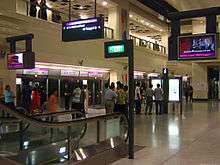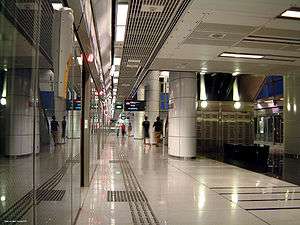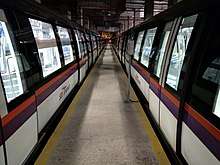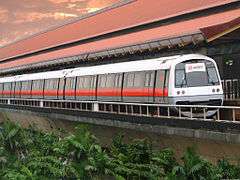North East MRT line
The North East Line (NEL) is the shortest Mass Rapid Transit line in Singapore. It is a high-capacity line, and runs from HarbourFront in the south-west to Punggol in the north-east. It is currently 19.2 kilometres (11.9 mi) long with 16 stations,[2] and a full journey from one end to the other takes 33 minutes.[3] The line is coloured purple on the rail map.
North East Line | ||||||||||||||||||||||||||||||||||||||||||||||||||||||||||||||||||||||||||||||||||||||||||||||||||||||||||||||||||||||||||||||||||||||||||||||||||||||||||||||||||||||||||||||||||||||||||||||||||||||||||||||||||||||||||||||||||||||||||||||||||||||||||||||||||||||||||||||||||||||||||||||||||||||||||||||||||||||||
|---|---|---|---|---|---|---|---|---|---|---|---|---|---|---|---|---|---|---|---|---|---|---|---|---|---|---|---|---|---|---|---|---|---|---|---|---|---|---|---|---|---|---|---|---|---|---|---|---|---|---|---|---|---|---|---|---|---|---|---|---|---|---|---|---|---|---|---|---|---|---|---|---|---|---|---|---|---|---|---|---|---|---|---|---|---|---|---|---|---|---|---|---|---|---|---|---|---|---|---|---|---|---|---|---|---|---|---|---|---|---|---|---|---|---|---|---|---|---|---|---|---|---|---|---|---|---|---|---|---|---|---|---|---|---|---|---|---|---|---|---|---|---|---|---|---|---|---|---|---|---|---|---|---|---|---|---|---|---|---|---|---|---|---|---|---|---|---|---|---|---|---|---|---|---|---|---|---|---|---|---|---|---|---|---|---|---|---|---|---|---|---|---|---|---|---|---|---|---|---|---|---|---|---|---|---|---|---|---|---|---|---|---|---|---|---|---|---|---|---|---|---|---|---|---|---|---|---|---|---|---|---|---|---|---|---|---|---|---|---|---|---|---|---|---|---|---|---|---|---|---|---|---|---|---|---|---|---|---|---|---|---|---|---|---|---|---|---|---|---|---|---|---|---|---|---|---|---|---|---|---|---|---|---|---|---|---|---|---|---|---|---|---|---|---|---|---|---|---|---|---|---|---|---|---|---|---|---|---|---|---|---|---|
 An Alstom Metropolis C751A train at Hougang | ||||||||||||||||||||||||||||||||||||||||||||||||||||||||||||||||||||||||||||||||||||||||||||||||||||||||||||||||||||||||||||||||||||||||||||||||||||||||||||||||||||||||||||||||||||||||||||||||||||||||||||||||||||||||||||||||||||||||||||||||||||||||||||||||||||||||||||||||||||||||||||||||||||||||||||||||||||||||
| Overview | ||||||||||||||||||||||||||||||||||||||||||||||||||||||||||||||||||||||||||||||||||||||||||||||||||||||||||||||||||||||||||||||||||||||||||||||||||||||||||||||||||||||||||||||||||||||||||||||||||||||||||||||||||||||||||||||||||||||||||||||||||||||||||||||||||||||||||||||||||||||||||||||||||||||||||||||||||||||||
| Native name | Laluan MRT Timur Laut 东北地铁线 வடக்கு கிழக்கு எம்ஆர்டி வழி | |||||||||||||||||||||||||||||||||||||||||||||||||||||||||||||||||||||||||||||||||||||||||||||||||||||||||||||||||||||||||||||||||||||||||||||||||||||||||||||||||||||||||||||||||||||||||||||||||||||||||||||||||||||||||||||||||||||||||||||||||||||||||||||||||||||||||||||||||||||||||||||||||||||||||||||||||||||||
| Type | Rapid transit | |||||||||||||||||||||||||||||||||||||||||||||||||||||||||||||||||||||||||||||||||||||||||||||||||||||||||||||||||||||||||||||||||||||||||||||||||||||||||||||||||||||||||||||||||||||||||||||||||||||||||||||||||||||||||||||||||||||||||||||||||||||||||||||||||||||||||||||||||||||||||||||||||||||||||||||||||||||||
| System | Mass Rapid Transit (Singapore) | |||||||||||||||||||||||||||||||||||||||||||||||||||||||||||||||||||||||||||||||||||||||||||||||||||||||||||||||||||||||||||||||||||||||||||||||||||||||||||||||||||||||||||||||||||||||||||||||||||||||||||||||||||||||||||||||||||||||||||||||||||||||||||||||||||||||||||||||||||||||||||||||||||||||||||||||||||||||
| Status | Operational Under construction (Punggol Coast) | |||||||||||||||||||||||||||||||||||||||||||||||||||||||||||||||||||||||||||||||||||||||||||||||||||||||||||||||||||||||||||||||||||||||||||||||||||||||||||||||||||||||||||||||||||||||||||||||||||||||||||||||||||||||||||||||||||||||||||||||||||||||||||||||||||||||||||||||||||||||||||||||||||||||||||||||||||||||
| Locale | Singapore | |||||||||||||||||||||||||||||||||||||||||||||||||||||||||||||||||||||||||||||||||||||||||||||||||||||||||||||||||||||||||||||||||||||||||||||||||||||||||||||||||||||||||||||||||||||||||||||||||||||||||||||||||||||||||||||||||||||||||||||||||||||||||||||||||||||||||||||||||||||||||||||||||||||||||||||||||||||||
| Termini | HarbourFront Punggol (until 2023) Punggol Coast (2023) | |||||||||||||||||||||||||||||||||||||||||||||||||||||||||||||||||||||||||||||||||||||||||||||||||||||||||||||||||||||||||||||||||||||||||||||||||||||||||||||||||||||||||||||||||||||||||||||||||||||||||||||||||||||||||||||||||||||||||||||||||||||||||||||||||||||||||||||||||||||||||||||||||||||||||||||||||||||||
| Stations | 16[lower-alpha 1] 1 (Under construction) | |||||||||||||||||||||||||||||||||||||||||||||||||||||||||||||||||||||||||||||||||||||||||||||||||||||||||||||||||||||||||||||||||||||||||||||||||||||||||||||||||||||||||||||||||||||||||||||||||||||||||||||||||||||||||||||||||||||||||||||||||||||||||||||||||||||||||||||||||||||||||||||||||||||||||||||||||||||||
| Services | 1 | |||||||||||||||||||||||||||||||||||||||||||||||||||||||||||||||||||||||||||||||||||||||||||||||||||||||||||||||||||||||||||||||||||||||||||||||||||||||||||||||||||||||||||||||||||||||||||||||||||||||||||||||||||||||||||||||||||||||||||||||||||||||||||||||||||||||||||||||||||||||||||||||||||||||||||||||||||||||
| Daily ridership | 601,000 (2019)[1] | |||||||||||||||||||||||||||||||||||||||||||||||||||||||||||||||||||||||||||||||||||||||||||||||||||||||||||||||||||||||||||||||||||||||||||||||||||||||||||||||||||||||||||||||||||||||||||||||||||||||||||||||||||||||||||||||||||||||||||||||||||||||||||||||||||||||||||||||||||||||||||||||||||||||||||||||||||||||
| Operation | ||||||||||||||||||||||||||||||||||||||||||||||||||||||||||||||||||||||||||||||||||||||||||||||||||||||||||||||||||||||||||||||||||||||||||||||||||||||||||||||||||||||||||||||||||||||||||||||||||||||||||||||||||||||||||||||||||||||||||||||||||||||||||||||||||||||||||||||||||||||||||||||||||||||||||||||||||||||||
| Planned opening | 2023 (Punggol Coast) | |||||||||||||||||||||||||||||||||||||||||||||||||||||||||||||||||||||||||||||||||||||||||||||||||||||||||||||||||||||||||||||||||||||||||||||||||||||||||||||||||||||||||||||||||||||||||||||||||||||||||||||||||||||||||||||||||||||||||||||||||||||||||||||||||||||||||||||||||||||||||||||||||||||||||||||||||||||||
| Opened | 20 June 2003 15 January 2006 (Buangkok) 20 June 2011 (Woodleigh) | |||||||||||||||||||||||||||||||||||||||||||||||||||||||||||||||||||||||||||||||||||||||||||||||||||||||||||||||||||||||||||||||||||||||||||||||||||||||||||||||||||||||||||||||||||||||||||||||||||||||||||||||||||||||||||||||||||||||||||||||||||||||||||||||||||||||||||||||||||||||||||||||||||||||||||||||||||||||
| Owner | Land Transport Authority | |||||||||||||||||||||||||||||||||||||||||||||||||||||||||||||||||||||||||||||||||||||||||||||||||||||||||||||||||||||||||||||||||||||||||||||||||||||||||||||||||||||||||||||||||||||||||||||||||||||||||||||||||||||||||||||||||||||||||||||||||||||||||||||||||||||||||||||||||||||||||||||||||||||||||||||||||||||||
| Operator(s) | SBS Transit (ComfortDelGro Corporation) | |||||||||||||||||||||||||||||||||||||||||||||||||||||||||||||||||||||||||||||||||||||||||||||||||||||||||||||||||||||||||||||||||||||||||||||||||||||||||||||||||||||||||||||||||||||||||||||||||||||||||||||||||||||||||||||||||||||||||||||||||||||||||||||||||||||||||||||||||||||||||||||||||||||||||||||||||||||||
| Character | Fully Underground | |||||||||||||||||||||||||||||||||||||||||||||||||||||||||||||||||||||||||||||||||||||||||||||||||||||||||||||||||||||||||||||||||||||||||||||||||||||||||||||||||||||||||||||||||||||||||||||||||||||||||||||||||||||||||||||||||||||||||||||||||||||||||||||||||||||||||||||||||||||||||||||||||||||||||||||||||||||||
| Depot(s) | Sengkang | |||||||||||||||||||||||||||||||||||||||||||||||||||||||||||||||||||||||||||||||||||||||||||||||||||||||||||||||||||||||||||||||||||||||||||||||||||||||||||||||||||||||||||||||||||||||||||||||||||||||||||||||||||||||||||||||||||||||||||||||||||||||||||||||||||||||||||||||||||||||||||||||||||||||||||||||||||||||
| Rolling stock | C751A C751C C851E (Future) | |||||||||||||||||||||||||||||||||||||||||||||||||||||||||||||||||||||||||||||||||||||||||||||||||||||||||||||||||||||||||||||||||||||||||||||||||||||||||||||||||||||||||||||||||||||||||||||||||||||||||||||||||||||||||||||||||||||||||||||||||||||||||||||||||||||||||||||||||||||||||||||||||||||||||||||||||||||||
| Technical | ||||||||||||||||||||||||||||||||||||||||||||||||||||||||||||||||||||||||||||||||||||||||||||||||||||||||||||||||||||||||||||||||||||||||||||||||||||||||||||||||||||||||||||||||||||||||||||||||||||||||||||||||||||||||||||||||||||||||||||||||||||||||||||||||||||||||||||||||||||||||||||||||||||||||||||||||||||||||
| Line length | 19.2 km (11.9 mi) (Operational) 1.6 km (0.99 mi) (Under construction) | |||||||||||||||||||||||||||||||||||||||||||||||||||||||||||||||||||||||||||||||||||||||||||||||||||||||||||||||||||||||||||||||||||||||||||||||||||||||||||||||||||||||||||||||||||||||||||||||||||||||||||||||||||||||||||||||||||||||||||||||||||||||||||||||||||||||||||||||||||||||||||||||||||||||||||||||||||||||
| Track gauge | 1,435 mm (4 ft 8 1⁄2 in) standard gauge | |||||||||||||||||||||||||||||||||||||||||||||||||||||||||||||||||||||||||||||||||||||||||||||||||||||||||||||||||||||||||||||||||||||||||||||||||||||||||||||||||||||||||||||||||||||||||||||||||||||||||||||||||||||||||||||||||||||||||||||||||||||||||||||||||||||||||||||||||||||||||||||||||||||||||||||||||||||||
| Electrification | 1500V DC Overhead catenary | |||||||||||||||||||||||||||||||||||||||||||||||||||||||||||||||||||||||||||||||||||||||||||||||||||||||||||||||||||||||||||||||||||||||||||||||||||||||||||||||||||||||||||||||||||||||||||||||||||||||||||||||||||||||||||||||||||||||||||||||||||||||||||||||||||||||||||||||||||||||||||||||||||||||||||||||||||||||
| Operating speed | limit of 90 km/h (56 mph) | |||||||||||||||||||||||||||||||||||||||||||||||||||||||||||||||||||||||||||||||||||||||||||||||||||||||||||||||||||||||||||||||||||||||||||||||||||||||||||||||||||||||||||||||||||||||||||||||||||||||||||||||||||||||||||||||||||||||||||||||||||||||||||||||||||||||||||||||||||||||||||||||||||||||||||||||||||||||
| ||||||||||||||||||||||||||||||||||||||||||||||||||||||||||||||||||||||||||||||||||||||||||||||||||||||||||||||||||||||||||||||||||||||||||||||||||||||||||||||||||||||||||||||||||||||||||||||||||||||||||||||||||||||||||||||||||||||||||||||||||||||||||||||||||||||||||||||||||||||||||||||||||||||||||||||||||||||||
First opened on 20 June 2003, it is the third line in the Singapore MRT system. It is the first MRT line in the network to use fully automated and driverless trains,[4] and is also the world's first fully underground and high-capacity driverless rapid transit line to use conventional steel-wheel technology (as opposed to the rubber-tyred, medium-capacity technology found in systems like VAL).[5] The North East Line is also the first line to feature Art in Transit across all 16 stations and full Wireless@SG coverage in all 16 stations. It is the first MRT line to be operated by SBS Transit. It is also the first MRT line to run entirely underground.
History
Plans for the line date back to 1986, when Communications Minister Yeo Ning Hong announced that it would be "feasible to extend the MRT once it is 3 million". Initially, the line would have stretched from Punggol and Seletar/Jalan Kayu to Outram Park. In 1993, the Land Transport Authority decided to extend the line southwards to HarbourFront, after noting the demand for people visiting the World Trade Centre (the present day HarbourFront Centre).
The Land Transport Authority received approval for the construction of the North East Line on 16 January 1996, shortly after the plans were feasible since the Hougang Central Bus Interchange opened on 17 December 1994. French company Alstom was chosen as the main contractor and manager of the project. The operating license was given to new rail operator Singapore Bus Service (present-day SBS Transit) on 20 May 1999 to foster competition with SMRT Trains.[6][7][8] Construction began on 1 January 1997 and was completed on 20 January 2001, with new signages installed in all stations.
The line was scheduled for completion in December 2002, but due to various problems in the automation, the opening was repeatedly delayed. It was finally opened on 20 June 2003, with higher fares than existing lines supposedly to compensate for the heavy construction costs (S$4.6 billion).[9][10][11][12][13]
Opening of reserved stations
When the line was opened, all of the stations were operating except Buangkok and Woodleigh. SBS Transit announced that these would open only when there was a critical mass of passengers in those areas. With respect to Buangkok, which had already been fully built, the company claimed that the projected number of passengers was too low to cover operating costs. Constant public pressure, notably the "White Elephant" incident and subsequent media attention, forced it to review the situation and the station duly opened on 15 January 2006. The last station on the line, Woodleigh, opened on 20 June 2011, in light of new developments near the station.[14]
On 17 December 2018, LTA announced that the line will undergo refurbishment from 2019 onwards. These works included reconditioning the line's signalling and power systems, and the installation of new rails and switches. A contract was also signed with CRRC Nanjing Puzhen for the overhaul of the line's first-generation rolling stock, to be completed between 2019 and 2024.[15]
North East Line extension
On 17 January 2013, the Land Transport Authority announced a 2-kilometre (1.2 mi) extension of the line from Punggol through Punggol North including the new Punggol Downtown. Initially planned to be completed by 2030,[16][17] on 7 June 2017, then Second Minister for Transport Ng Chee Meng announced that the extension will open in 2023, 7 years ahead of the expected opening date. The single station extension will span 1.6 kilometres (0.99 mi) and will serve the future Punggol North area, along with the planned "creative cluster and learning corridor" in Punggol.[18] Construction on the extension commenced in 2018.[19][20]
Network and operations
Services
As of 2017, trains operate at two to three-minute intervals during weekday peak hours, four to five-minute intervals during weekday off-peak hours and three-and-a-half to five-minute intervals on weekends.[21]
Route

As the name implies, the fully-underground 19.2-kilometre (11.9 mi) North East Line connects Central Singapore to the north-eastern parts of the island, serving a total of 16 stations.[2] Beginning at HarbourFront station,[22] the line goes in a northeast direction, paralleling the New Bridge Road and Eu Tong Street in Chinatown between Outram Park and Clarke Quay stations.[23] Passing underneath the Singapore River and Fort Canning Hill to Dhoby Ghaut station,[24] the line continues to follow the route of Race Course Road and Serangoon Road through Little India and Boon Keng.[25] Between Potong Pasir and Kovan stations, it parallels Upper Serangoon Road, then it curves north to Hougang station.[26] The line then runs below Hougang Avenue 6 and Sengkang Central to Sengkang station in Sengkang and further extends to Punggol station in Punggol, where it currently terminates.[27] The NEL will continue to curve towards Punggol Coast MRT station in 2023.[18][28][29][30]
Stations
| Station number | Station name | Image | Interchange/notes |
| NE1 CC29 | HarbourFront | Interchange with the Circle line | |
| NE2 | reserved; under planning | Reserve station to be open at a later date | |
| NE3 EW16 TE17 | Outram Park | Interchange with the East West line and the Thomson-East Coast line (2021) | |
| NE4 DT19 | Chinatown |  | Interchange with the Downtown line |
| NE5 | Clarke Quay | ||
| NE6 NS24 CC1 | Dhoby Ghaut | Interchange with the North South line and the Circle line | |
| NE7 DT12 | Little India | Interchange with the Downtown line | |
| NE8 | Farrer Park |  | |
| NE9 | Boon Keng | ||
| NE10 | Potong Pasir |  | |
| NE11 | Woodleigh |  | |
| NE12 CC13 | Serangoon |  | Interchange with the Circle line |
| NE13 | Kovan |  | |
| NE14 CR8 | Hougang | _-_Platform.jpg) | Interchange with the Cross Island line (2029) |
| NE15 | Buangkok | ||
| NE16 STC | Sengkang |  | Interchange with the Sengkang LRT |
| NE17 PTC CP4 | Punggol | Interchange with the Punggol LRT and Cross Island line (2031) | |
| North East Line extension (under construction, to be ready by 2023) | |||
|---|---|---|---|
| NE18 | Punggol Coast | ||
The North East Line's numbering scheme reserves station code "NE2" for future use.
Rolling stock


The rolling stock consists of Alstom Metropolis trains ordered under C751A and C751C contracts, running in a six-car formation. These trains operate from Sengkang Depot near Buangkok station, which also houses maintenance and train overhaul facilities.
In 2010, the government announced that they were looking to increase the number of trains on the North East Line by 70% within 5 to 6 years to cater to an expected increase in passenger traffic. 18 trains of six cars each were purchased under turnkey contract C751C, and entered service in October 2015.[31][32]
The North East Line is the only line in Singapore's MRT network that utilises overhead line electrification; all other lines take power from a third rail.
In 2018, a further 36 rail cars (6 train-sets) were acquired to cater to the future extension of the line to Punggol Coast. [33]
Train control
The North East Line is equipped with Alstom Urbalis 300 Communications-based train control (CBTC) moving block signalling system on the MASTRIA system with Automatic train control (ATC) under Automatic train operation (ATO) GoA 4 (UTO).[34][35][36] The subsystems consist of Automatic train protection (ATP) to govern train speed, Iconis Automatic Train Supervision (ATS) to track and schedule trains and Smartlock Computer-based interlocking (CBI) system that prevents incorrect signal and track points to be set.
Train Data Management System (TDMS) which concentrate and dispatch the rolling stock information with fixed equipment. The IAGO Waveguide communications network has the capability to transmit video and is almost maintenance-free. Base stations are located within the signalling equipment room.
Automatic platform screen doors supplied by Westinghouse provide safety for passengers, offering protection from arriving and departing trains.
See also
- List of driverless trains
External links
Notes and references
Notes
- excluding reserved station for NE2
References
- "SBS Transit posts 1.5% rise in full-year net profit of S$81.3m". 13 February 2020. Archived from the original on 20 March 2020. Retrieved 21 March 2020.
- "North East Line". Land Transport Authority. Archived from the original on 28 August 2017. Retrieved 22 June 2017.
- Travel Time Archived 20 October 2007 at the Wayback Machine, SBS Transit
- "Singapore Northeast Line" (PDF). Alstom. Archived (PDF) from the original on 16 May 2008. Retrieved 29 May 2009.
- "Wayback Machine" (PDF). web.archive.org. 8 December 2019. Retrieved 8 December 2019.
- "Appointment of operator for the North East MRT line". NAS. 20 May 1999. Archived from the original on 23 November 2019. Retrieved 22 November 2019.
- "SBS to run North-East line Tibs to merge with SMRT". The Straits Times (retrieved from NLB). 21 May 1999. Archived from the original on 6 October 2019. Retrieved 6 October 2019.
- "Opening Of North East Line". www.mot.gov.sg. Retrieved 25 April 2020.
- "Singapore Northeast Line". Railway Technology. Archived from the original on 29 January 2018. Retrieved 24 April 2020.
- "Higher fares for new MRT line". The New Paper. 9 May 2003.
- "Speech By Mr Khaw Boon Wan At The Launch Of The North East Line Art In Transit Programme On 6 June 2003". www.mot.gov.sg. Retrieved 25 April 2020.
- "Speech By Deputy Prime Minister Mr Lee Hsien Loong At The Official Opening Of The North East Line And Sengkang LRT System on 28 August 2003". www.mot.gov.sg. Retrieved 25 April 2020.
- "No Revision To Bus And Train Fares And New NEL Fare Structure Approved". www.mot.gov.sg. Retrieved 26 April 2020.
- "Train finally arrives at Woodleigh MRT station". Channel NewsAsia. 20 June 2011. Archived from the original on 4 May 2012. Retrieved 11 May 2012.
- "NEL to undergo major renewal from January". The Straits Times. 17 December 2018. Archived from the original on 19 December 2018. Retrieved 19 December 2018.
- "Speech by Mr Lui Tuck Yew at visit to DTL1 Chinatown Station on 17 January 2013". MOT. 17 January 2013. Archived from the original on 26 February 2020. Retrieved 19 September 2019.
- "Two New Rail Lines and Three New Extensions to Expand Rail Network by 2030". Land Transport Authority. 17 January 2013. Archived from the original on 6 July 2014.
- "New train station in Punggol North by 2023". Channel NewsAsia. 7 June 2017. Archived from the original on 7 June 2017. Retrieved 7 June 2017.
- "North-East Line extension serving Punggol North to open in 2023 instead of 2030; to cater to developments in the Punggol area". The Straits Times. 7 June 2017. Archived from the original on 11 June 2017. Retrieved 28 October 2017.
- "LTA | Upcoming Projects | Rail Expansion | North East Line Extension". www.lta.gov.sg. Retrieved 15 May 2020.
- "First/Last Train Info". SBS Transit. Archived from the original on 28 June 2017. Retrieved 22 June 2017.
- OpenStreetMap contributors. "HabourFront station on North East Line (NE)" (Map). OpenStreetMap. Retrieved 15 May 2020.
- OpenStreetMap contributors. "NEL underneath New Bridge Road" (Map). OpenStreetMap. Retrieved 15 May 2020.
- OpenStreetMap contributors. "NEL underneath Singapore River and Fort Canning Hill" (Map). OpenStreetMap. Retrieved 15 May 2020.
- OpenStreetMap contributors. "Race Course Road and Serangoon" (Map). OpenStreetMap. Retrieved 15 May 2020.
- OpenStreetMap contributors. "NEL under Upper Serangoon Road" (Map). OpenStreetMap. Retrieved 15 May 2020.
- OpenStreetMap contributors. "NEL from Hougang to Punggol" (Map). OpenStreetMap. Retrieved 15 May 2020.
- OpenStreetMap contributors. "NEL from Hougang to Punggol" (Map). OpenStreetMap. Retrieved 15 May 2020.
- "LTA | Upcoming Projects | Rail Expansion | North East Line Extension". www.lta.gov.sg. Retrieved 15 May 2020.
- "North East Line extension". www.lta.gov.sg. Archived from the original on 5 February 2018.
- "LTA and SMRT Award Contracts for New Trains and Re-Signalling Project". Land Transport Authority. 1 February 2012. Archived from the original on 29 September 2013. Retrieved 16 November 2013.
- "Alstom to supply 34 Metropolis trains and signaling upgrade to Singapore metro". 3 February 2012. Archived from the original on 31 December 2013. Retrieved 16 November 2013.
- "Alstom to supply 17 additional Metropolis trains for Singapore Circle Line and North East Line | The French Chamber of Commerce in Singapore". www.fccsingapore.com. Archived from the original on 9 August 2018. Retrieved 9 August 2018.
- "Singapore Northeast Line: will soon be the largest, fully automatic metro system in the world" (PDF). pp. 4 to 8. Archived (PDF) from the original on 16 June 2020. Retrieved 16 June 2020.
- "URBALIS Evolution: Controlling the Performance" (PDF). p. 4. Archived (PDF) from the original on 16 June 2020. Retrieved 16 June 2020.
- "Singapore Northeast Line". Archived from the original on 20 July 2016. Retrieved 21 August 2016.

.jpg)